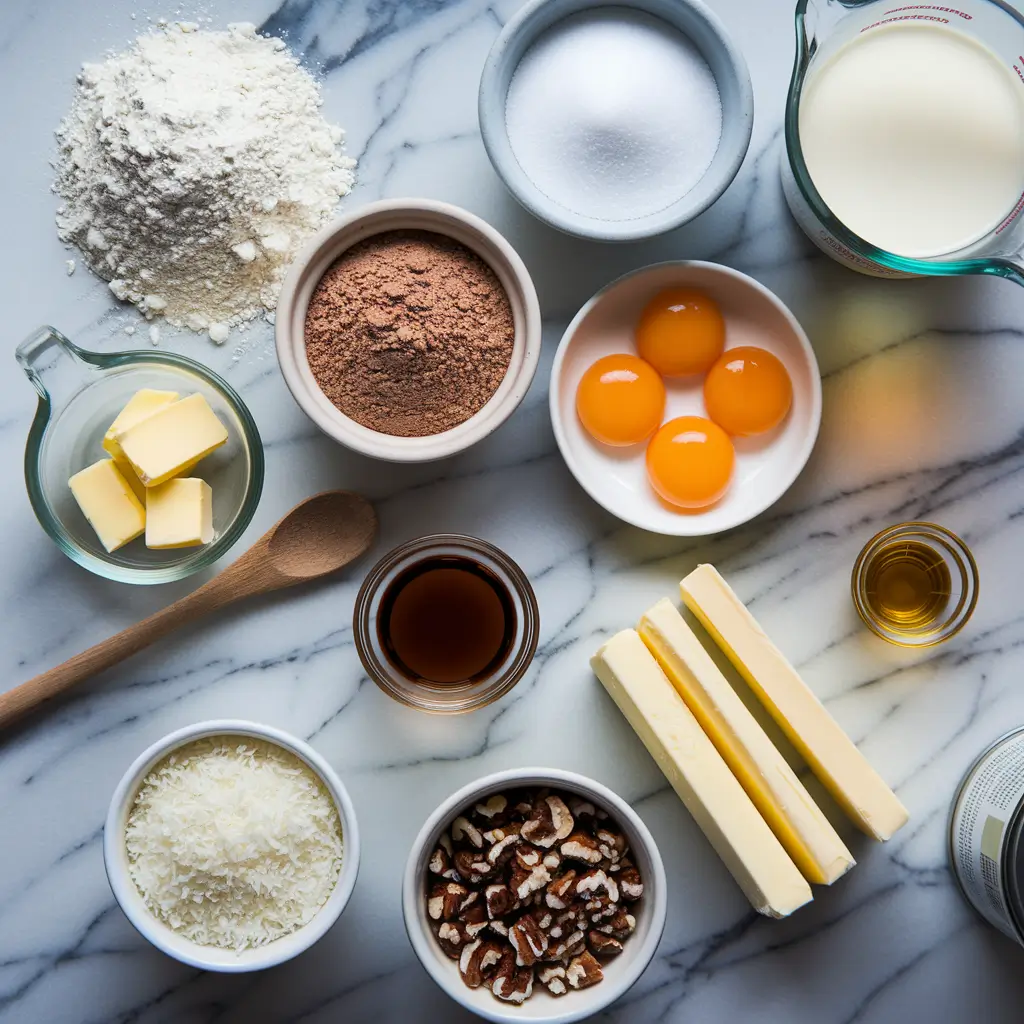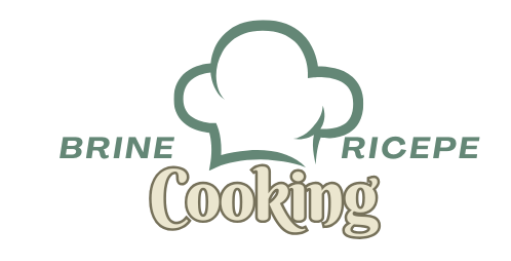Looking for the best German chocolate cake recipe that’s moist, rich, and loaded with flavor? This classic dessert pairs tender chocolate cake layers with a luscious coconut-pecan filling. Whether you’re baking for a birthday, holiday, or dinner party—this recipe will impress every time. This cake isn’t just a dessert; it’s an experience, a delightful combination of textures and tastes that has captivated bakers and eaters for generations. From the first moist, chocolatey bite to the satisfying crunch of the coconut-pecan frosting, this German chocolate cake recipe is crafted to be the ultimate version you’ll ever need. Get ready to create a show-stopping cake that will have everyone asking for seconds!
Table of Contents
- What Is German Chocolate Cake?
- Ingredients
- Step-by-Step Instructions
- Expert Tips for Success
- Storage & Freezing
- Flavor Variations
- Frequently Asked Questions
- Troubleshooting Common Issues
- Serving Suggestions
- The Science of Baking
- Community Love for This Recipe
What Is German Chocolate Cake?
Despite its name, German chocolate cake is a delightful piece of American culinary history. It wasn’t invented in Germany, but rather its name comes from Samuel German, an American baker who developed a type of dark baking chocolate for the Baker’s Chocolate Company in 1852. This specific chocolate, known as “Baker’s German’s Sweet Chocolate,” was milder and sweeter than other baking chocolates available at the time, making it perfect for creating richer and more palatable desserts.
The recipe that propelled this cake to national fame didn’t emerge until nearly a century later. In 1957, a recipe for “German’s Chocolate Cake” appeared in the Dallas Morning News. This recipe, created by a Texas homemaker named Mrs. George Clay, utilized Baker’s German’s Sweet Chocolate and featured the now-iconic coconut-pecan frosting. The popularity of this recipe soared, and soon, the apostrophe was dropped, leading to the name we know today: German chocolate cake.
The key distinguishing feature of a traditional German chocolate cake is not just the moist chocolate layers, which often incorporate buttermilk and coffee to enhance flavor and texture, but also the rich and gooey coconut-pecan frosting. Unlike many other chocolate cakes that are paired with buttercream or ganache, the German chocolate cake’s frosting is a custard-based concoction, typically made with evaporated milk, sugar, egg yolks, butter, vanilla, shredded coconut, and chopped pecans. This frosting provides a unique textural contrast to the soft cake layers and a flavor profile that is both sweet and nutty.
“It’s not just a cake—it’s a celebration in every slice! The history behind it adds another layer of appreciation to this beloved classic.”
Ingredients for the Best German Chocolate Cake

To bake the best German chocolate cake, you’ll need a selection of high-quality ingredients for both the cake layers and the signature frosting. Here’s a detailed breakdown:
For the Cake:
- 2 cups all-purpose flour: Provides the structure for the cake. Ensure it’s measured accurately (spoon and level method is recommended).
- 2 cups granulated sugar: Sweetens the cake and contributes to its moistness.
- 3/4 cup unsweetened cocoa powder: Gives the cake its rich chocolate flavor. Use a good quality cocoa powder for the best taste.
- 2 tsp baking soda: A leavening agent that helps the cake rise.
- 1 tsp baking powder: Another leavening agent, providing a slightly different lift and texture.
- 1/2 tsp salt: Enhances the flavors of the other ingredients.
- 1 cup buttermilk, room temperature: Adds moisture and a slight tanginess that tenderizes the cake. If you don’t have buttermilk, you can make a substitute (see tips section).
- 1 cup strong brewed coffee (or hot water): Intensifies the chocolate flavor and adds moisture. Don’t worry, the coffee flavor will be subtle.
- 1/2 cup vegetable oil: Contributes to the cake’s moist and tender crumb.
- 2 large eggs, room temperature: Provide structure and richness. Room temperature eggs emulsify better, leading to a smoother batter.
- 2 tsp vanilla extract: Enhances the overall flavor profile.
For the Coconut-Pecan Frosting:
- 1 cup evaporated milk: The base of the custard frosting, providing richness.
- 1 cup granulated sugar: Sweetens the frosting and helps create the right consistency.
- 3 large egg yolks: Add richness and help thicken the frosting into a luscious custard.
- 1/2 cup unsalted butter: Contributes to the smooth texture and flavor of the frosting.
- 1 tsp vanilla extract: Enhances the overall flavor of the frosting.
- 1 1/3 cups sweetened shredded coconut: The signature ingredient that provides a chewy texture and tropical flavor.
- 1 cup chopped pecans: Adds a delightful crunch and nutty flavor that complements the coconut and chocolate. Toasted pecans offer an even deeper flavor.
Step-by-Step Instructions
Follow these detailed instructions to bake your best German chocolate cake:
Making the Cake:
- Preheat and Prepare: Preheat your oven to 350°F (175°C). Grease the bottoms and sides of three 9-inch round cake pans with butter or cooking spray. Line the bottoms with parchment paper circles to prevent sticking.
- Combine Dry Ingredients: In a large mixing bowl, whisk together the all-purpose flour, granulated sugar, unsweetened cocoa powder, baking soda, baking powder, and salt until well combined. This ensures even distribution of the leavening agents and cocoa.
- Combine Wet Ingredients: In a separate bowl, whisk together the room temperature buttermilk, strong brewed coffee (or hot water), vegetable oil, room temperature large eggs, and vanilla extract until the mixture is smooth.
- Mix the Batter: Gradually add the wet ingredients to the dry ingredients, mixing on low speed until just combined. Be careful not to overmix at this stage. Once the wet and dry ingredients are mostly incorporated, increase the speed to medium and beat for 1-2 minutes until the batter is smooth and lump-free. The batter will be quite thin, which is normal.
- Divide and Bake: Evenly divide the cake batter among the prepared cake pans. Bake in the preheated oven for 30 to 35 minutes, or until a wooden skewer inserted into the center of a cake layer comes out clean. The baking time may vary slightly depending on your oven.
- Cool the Cakes: Once baked, remove the cake pans from the oven and let them cool in the pans for about 10-15 minutes. Then, carefully invert the cakes onto a wire rack, remove the parchment paper, and let them cool completely before frosting. Cooling the cakes completely is crucial to prevent the frosting from melting.
Preparing the Frosting:
- Combine Base Ingredients: In a medium saucepan, combine the evaporated milk, granulated sugar, and large egg yolks. Whisk them together thoroughly until the yolks are well incorporated.
- Cook the Custard: Place the saucepan over medium heat and cook, stirring constantly with a wooden spoon or spatula, until the mixture thickens and coats the back of the spoon. This usually takes about 10 to 12 minutes. Be patient and keep stirring to prevent the eggs from scrambling. The mixture should be thick enough that a line drawn on the back of the spoon with your finger holds its shape.
- Add Butter and Vanilla: Once the custard has thickened, remove the saucepan from the heat and stir in the unsalted butter until it is completely melted and the frosting is smooth. Then, stir in the vanilla extract.
- Stir in Coconut and Pecans: Add the sweetened shredded coconut and chopped pecans to the warm frosting and stir until they are evenly distributed.
- Cool the Frosting: Allow the frosting to cool completely to room temperature before assembling the cake. The frosting will thicken further as it cools, reaching a spreadable consistency. This step is important to prevent a runny frosting.
Assembling the Cake:
- Level the Cake Layers (Optional): If your cake layers have a domed top, you can use a serrated knife to carefully level them. This will make stacking easier and the finished cake more even.
- First Layer: Place one cake layer on your serving plate or cake stand. Spread an even layer of the coconut-pecan frosting over the top of the cake layer.
- Second Layer: Carefully place the second cake layer on top of the frosting. Spread another even layer of the frosting over this layer.
- Third Layer: Place the final cake layer on top. Frost the top of the cake with the remaining coconut-pecan frosting.
- Frost the Sides (Optional): Traditionally, the sides of a German chocolate cake are often left unfrosted, showcasing the chocolate layers. However, you can certainly frost the sides as well if you prefer a more finished look.
- Chill (Optional): For easier slicing, you can chill the assembled cake in the refrigerator for about 30 minutes before serving.

Expert Tips for Success
Here are some expert tips to help you achieve the perfect German chocolate cake:
Ingredient Preparation:
- Room Temperature Matters: Ensure that your eggs and buttermilk are at room temperature. This helps them emulsify properly with the fat, resulting in a smoother batter and a more tender cake.
- Buttermilk Substitute: If you don’t have buttermilk, you can make a quick substitute by adding 1 tablespoon of lemon juice or white vinegar to a liquid measuring cup, then filling it with milk to the 1-cup mark. Let it sit for 5-10 minutes until it thickens slightly.
- Coffee Enhancement: Don’t skip the coffee! It really enhances the chocolate flavor without making the cake taste like coffee
The Creator’s Favorite Recipe Selections
Delicious Korean Ground Beef Bowl
Final Verdict: Do you think you should try this recipe?
4.0 out of 5 stars (based on 1 review)Incredible Flavor and Texture – A Must-Try!
April 21, 2025Chicken of the Woods totally surprised me. I sautéed it with olive oil, garlic, and a splash of white wine, and it turned out absolutely delicious—meaty, tender, and packed with umami. The texture is so close to chicken that even my meat-loving friends were impressed. It’s now a seasonal staple in my kitchen. Highly recommend for anyone looking to explore wild mushrooms or add a flavorful plant-based protein to meals.

